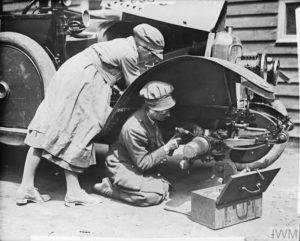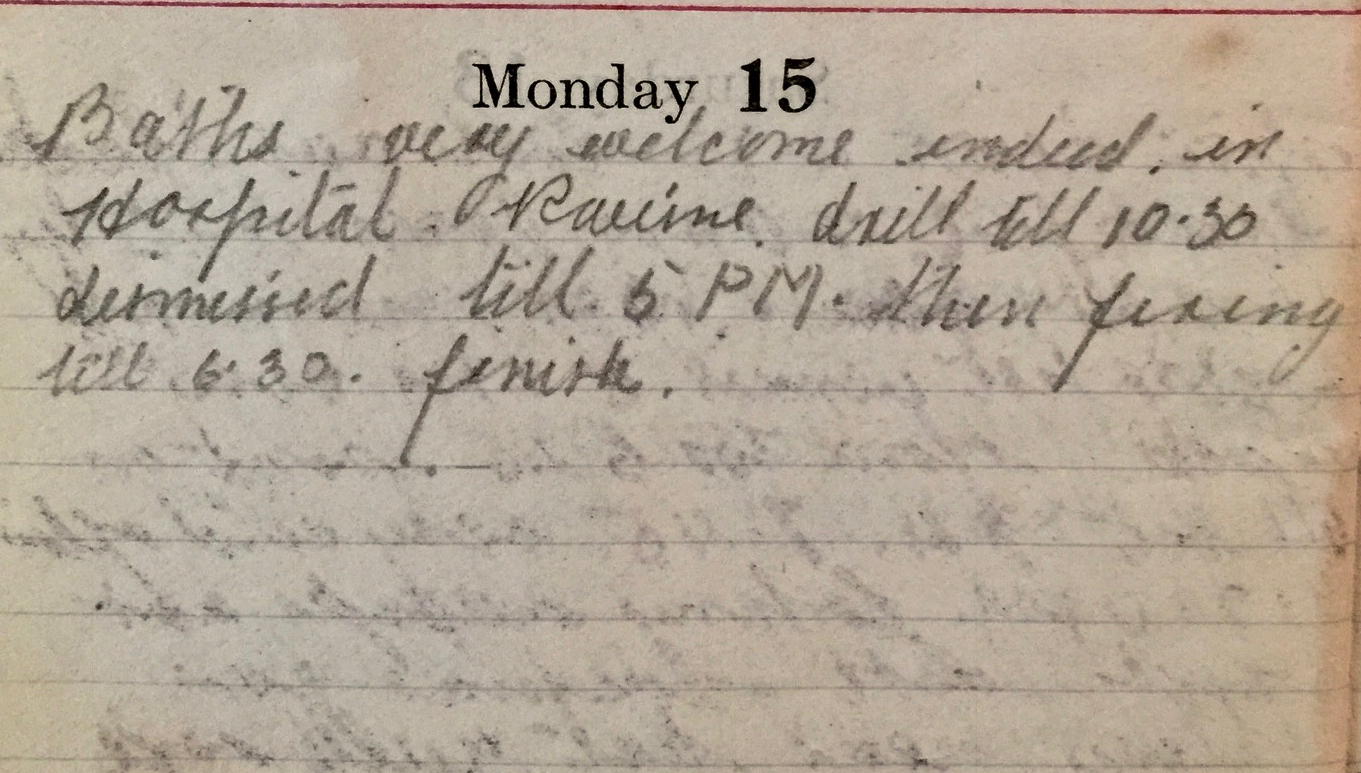Monday April 15th, 1918
Baths very welcome indeed in Hospital Ravine. Drill till 10:30 dismissed till 5pm then firing till 6:30 finish.
Women’s Army Auxiliary Corps Vindicated
An interesting tale. A few weeks ago the Undersecretary of State for War reported to Parliament that‘Over 20,000 women had been enrolled in the WAAC. They were doing most useful work, and he regretted that malicious rumours should find currency regarding them.’¹

The Women’s Army Auxiliary Corps had been formed in August 1917 and was the first instance of a Western nation employing women within the armed services. It was created to release to the front line men working in non-combatant roles within the army. Consequently the WAAC worked as clerks, domestic workers, mechanics, drivers, cooks and tailors.
There was great concern that they did not appear too militaristic. Therefore while its recruits wore a form of military uniform, they were not given military titles. Senior women were referred to as Administrators or Controllers and the troops as Workers. Rank was denoted by symbols of flowers.²
The majority of WAAC served in Britain, though several thousand were sent to France and Flanders. When the US joined the war, around 5,000 WAAC also supported its forces in Britain and abroad.
Imagine therefore the consternation of the authorities when rumours began circulating in early 1918 of the loose morals of the WAAC, apparently with the collusion of the Army! This is to what Mr Macpherson was alluding. It led quickly to a formal inquiry and a public rebuttal.
On this day in 1918, the newspapers were full of its findings. The Guardian, under the title, ‘WAAC Vindicated, Unfounded Charges’ reported, ‘The Commission of Inquiry recently appointed by the Ministry of Labour, in consultation with Lord Derby, to visit France in connection with charges of immoral conduct brought against the WAAC have completed their investigation, and have presented a unanimous report. Their conclusion is that the charges brought against the WAAC in France rest on no foundation in fact.’‡
Silencing the Critics

At a time when it was important to make every able-bodied man available for active service, anything that hampered the recruitment of women as their replacements had to be stamped on: ‘The military note in the daily life of the women’s camps is not strongly marked and so far as it exists is concerned primarily with the maintenance of decorum and good manners among the girls. An honest and self-respecting girl who wishes to lead a steady life is, we believe, assured of every opportunity of doing so when serving with the WAAC in France.’‡
The photograph shows two fitters of the WAAC at work on a car at Etaples, France in June 1918.
The authorities were also quick to act against rumour mongers. In Congleton in Cheshire, the Reverend Richard Henry Quick, minister of the Primitive Methodist Chapel was charged under the Defence of the Realm Act. He was accused of making false statements maligning the morals of the WAAC and alluding to the complicity of the British Government. He was convicted on 15th April 1918 and fined £40.ª
Ultimate respectability was conferred when, earlier the same month, Queen Mary became its Commandant-in-Chief. Ostensibly the service became ‘Queen Mary’s Army Auxiliary Corps’ (QMAAC), though this name didn’t seem to stick.
These remediation strategies worked their magic and by the end of the war, there were 57,000 WAAC.² The Navy also established the WRNS (aka Wrens) in August 1917. The WRAF was established in 1918. They proved equally popular and useful, but all three were to be disbanded by 1921.
As war loomed again, the Auxiliary Territorial Service, established in 1938, was the natural successor to the WAAC.³ The Women’s Auxiliary Air Force was formed in 1939 and would again become the WRAF in 1949 before being fully integrated into the RAF in 1994.º The WRNS was re-established, name intact, at the beginning of WWII and remained in place until 1993 when it was fully integrated into the Royal Navy.†
13th (Service) Battalion War Diary – 15th April 1918 – Saida
Work and training as per programme (App No 3). Every officer whose permanent rank is below that of Lt Col will be supplied with a record of service book, ‘Army Book 439’¤ which will be kept up according to the instruction contained within it.
References & Further Reading
¹’Committee of Supply’ about the Army Estimates, Mr Macpherson’s comments, The Guardian, February 21st, 1918, page 8
‡ The Guardian, April 15th, 1918
ª The Guardian, April 16th, 1918
2 ‘Women’s Army Auxiliary Corps‘ WWI East Sussex
³ Queen Mary’s Army Auxiliary Corps on Wikipedia
º ‘WRAF’ on Wikipedia
† ‘WRNS‘ on Wikipedia
* Q 68242, copyright Imperial War Museums
# Q 9047 copyright Imperial War Museums
Innovating in Combat, Royal Engineers Archives
¤ Army Book 439 was an officer’s record of service. It was designed to contain personal details such as date of birth and home address and to record languages, courses, promotions, service, extra-regimental employment, mentions in despatches and rewards.


